08.02.10
Posted in Non-US Weather, Weather News at 8:17 am by Rebekah
As a follow-up to this past week’s posts on the heat wave in western Russia, here is a plot of the temperature anomaly for July 29th, Moscow’s hottest day on record.
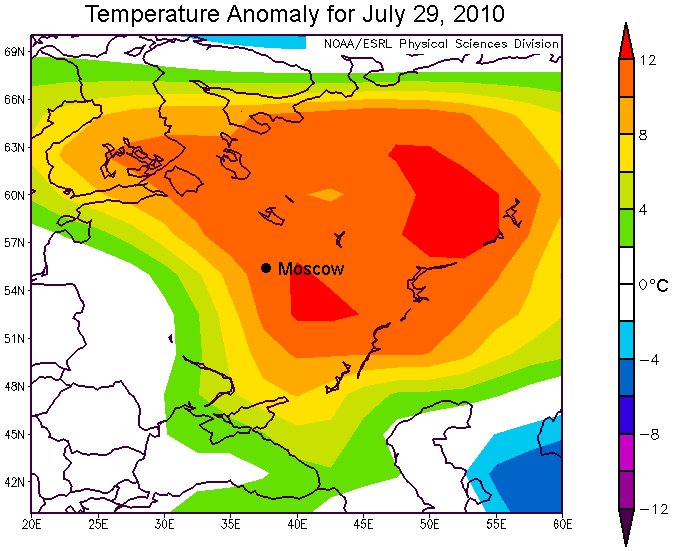
Note that the average temperature for Moscow on this day was 10 to 12 °C (18 to 22 °F) higher than the climatological average temperature for July 29th.
Although temperatures have since cooled down a few degrees, Russia is still under a massive ridge. This ridge will continue to build through at least the end of this week, when temperatures in Moscow could reach 100 °F or greater (possibly breaking the new record yet again).
Permalink
07.29.10
Posted in Non-US Weather, Weather News at 12:10 pm by Rebekah
On Tuesday, I posted on how western Russia is in the midst of a record heat wave. On Monday, Moscow had broken the record for the city’s all-time highest temperature, at 37.4 °C (99.3 °F).
However, as the model forecast I showed on Tuesday predicted, Moscow broke that record AGAIN today!
Currently, the all-time highest temperature for Moscow is 37.8 °C (100.0 °F), set on 29 July 2010 at 4:00 pm.
Some parts of Moscow reached temperatures as high as 39 °C (102 °F), but the official record stands at the location where weather records have been taken for the last 130 years.
According to Weather Underground, the previous record temperature for July 29th in Moscow was set in 2002, at 86 °F (30 °C), while the average temperature for this day is only 68 °F (20 °C)!
Some relief may be found soon, though, as a cold front is expected to pass through tomorrow and drop the temperatures a bit.
With regard to the fires around Moscow, they are not as large as the ones in far eastern Russia that John brought to my attention in his comment on Tuesday’s post (check out this amazing satellite image he linked to); however, they are affecting a more populated area and causing serious health problems.
I have seen Alexander Chuchalin, Russia’s chief pulmonary doctor, cited in several news articles as saying the current level of carbon monoxide in the air in Moscow could have the same effect on someone as smoking two packs of cigarettes every three to four hours.
The smoke should at least begin to disperse as the front moves through tomorrow with a chance of showers.
Permalink
07.27.10
Posted in Non-US Weather, Weather News at 10:59 pm by Rebekah
This week’s post in the global weather and climate series features Moscow, Russia.
-
-
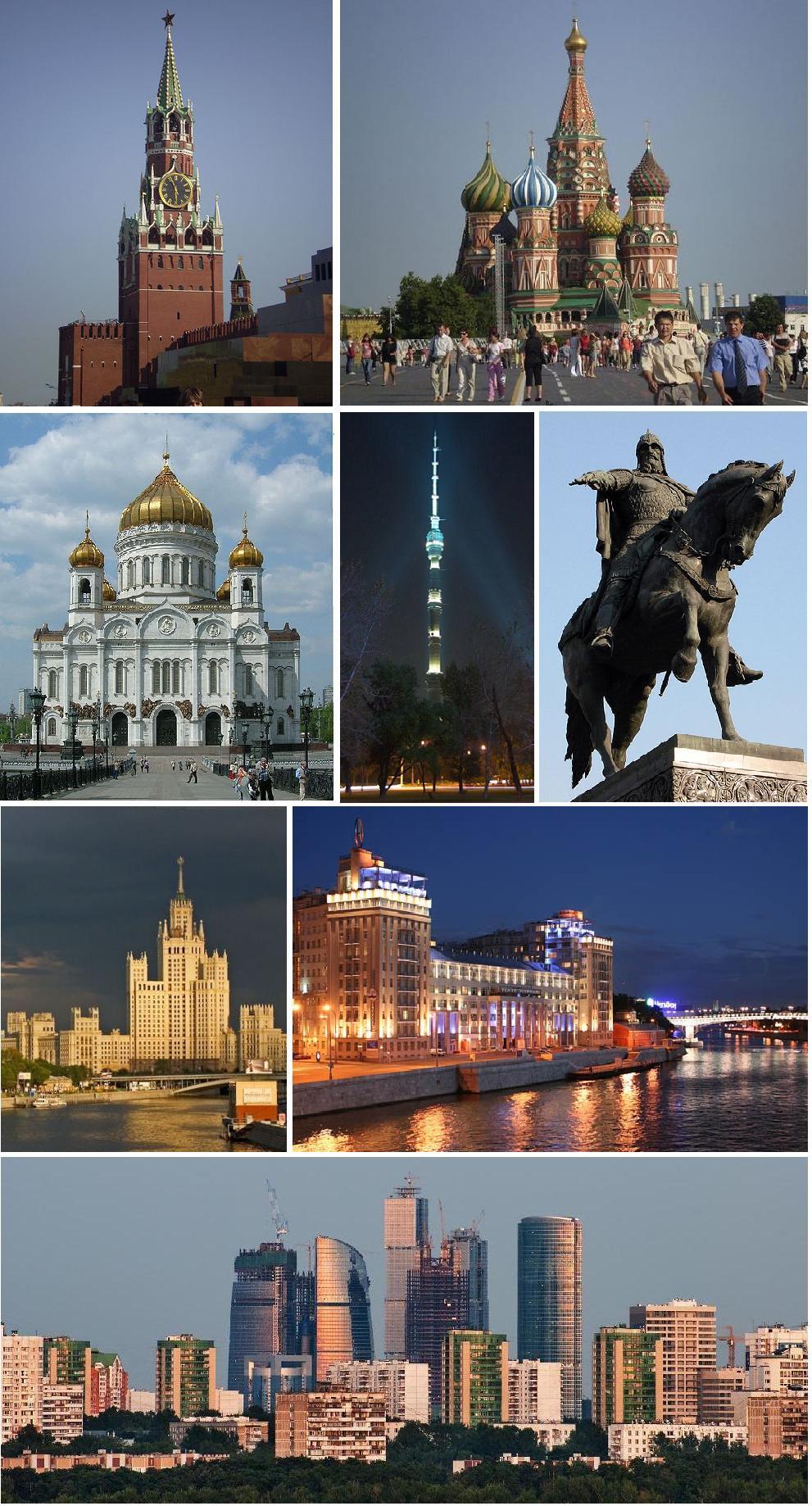
Moscow, Russia (click to enlarge). Courtesy of Wikipedia.
The most populous city in Russia and second largest in Europe (only London’s metro is larger), Moscow is located in west central Russia, on the Moskva River. By most definitions, Moscow is in eastern Europe rather than in Asia. Moscow, dating back to at least the 12th century, was the capital city of the U.S.S.R. and is currently the capital of Russia. Moscow was the site of the 1980 summer Olympic Games, which were boycotted by the United States and several western European countries. Moscow is home to about 10.6 million people.
A few more facts about Moscow (from Wikipedia):
- Time zone: Moscow Standard Time (UTC+3) or Moscow Summer Time (UTC+4)
- Elevation: 512 to 837 ft above mean sea level
- Climate zone: Humid continental (warm, somewhat humid summers and long, cold winters)
- Average high temperature: 49 °F (9 °C)
- Average low temperature: 35 °F (2 °C)
- Record high temperature: 99 °F (37 °C) – recorded on 26 July 2010!
- Record low temperature: -44 °F (-42 °C)
- Average annual precipitation: 28 inches (700 mm)
Current weather: Russia is currently in the midst of a record heat wave; as noted above, the all-time record high temperature in Moscow (over 130 years of records) was set yesterday, at 99.3 °F (37.4 °C), and it’s possible that that record could break yet again over the next few days.
Thursday’s GFS temperature forecast (in Celsius), for 4 pm local Moscow time (Moscow can be found just south of Belarus’ northern border and just west of Ukraine’s eastern border):
(Courtesy of Weather Online UK; click to enlarge)
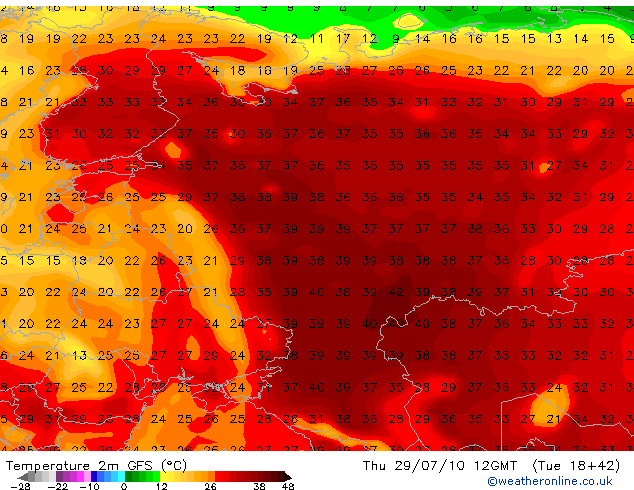
Note the forecast high is for 37 to 39 °C! Moscow’s normal high for this time of year is around 23 °C.
Why is it so hot?
I’m a little unfamiliar with Russian microclimates and geography, but one big reason is that there is a large ridge of high pressure that has built across western Russia (see 500 mb 00Z initialization of the ECMWF model, below, valid for 4 am Wednesday, local Moscow time).
(Courtesy of Weather Online UK; click to enlarge)
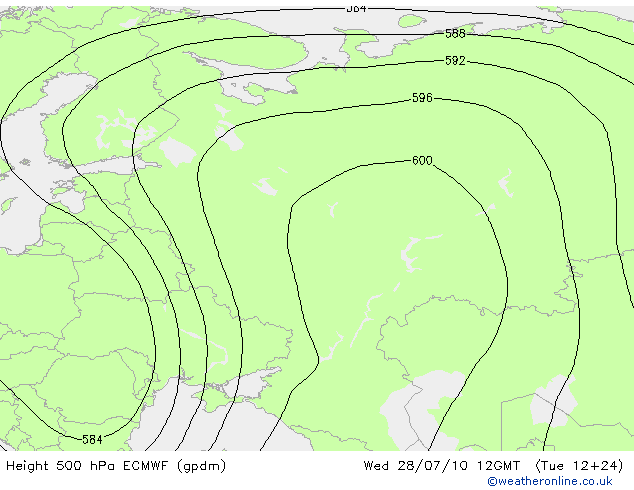
This ridge is associated with a surface high, seen below (for the same time as the above map).
(Courtesy of Weather Online UK; click to enlarge)
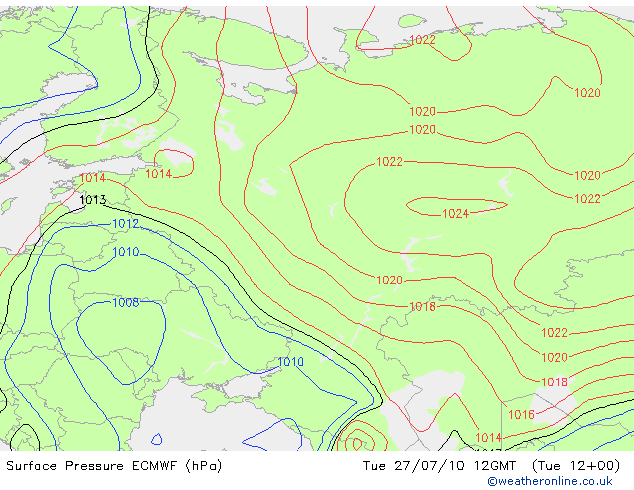
This high pressure has brought and will continue to bring, for the next several days, dry, sinking air and warm south / southeasterly winds to western Russia.
To make matters worse, there are also some 60 forest and peat fires ongoing near Moscow, covering about 145 acres, according to the BBC. Doctors have advised residents to keep their windows closed and to wear masks to avoid inhaling ash particles as the smoke and smog is so thick.
The sinking air associated with the high pressure is a large part of the problem, as it has prevented much of the smoke from dissipating and has kept it trapped close to the surface.
For more information on Moscow, here’s a link to Wikipedia.
For weather maps and information on current and forecast Moscow weather, see Weather Online UK (collection of maps and weather information for all over the world) and the Hydrometeorological Center of Russia (Russia’s national weather service – it is in English!).
Next Tuesday I plan to take a look at the climate and weather in another part of the globe. As always, if you have any comments or suggestions for future cities, please leave a comment on this post!
Permalink
07.06.10
Posted in Non-US Weather, Weather News at 10:37 pm by Rebekah
This week’s post in the global weather and climate series features Johannesburg, South Africa.
-
-
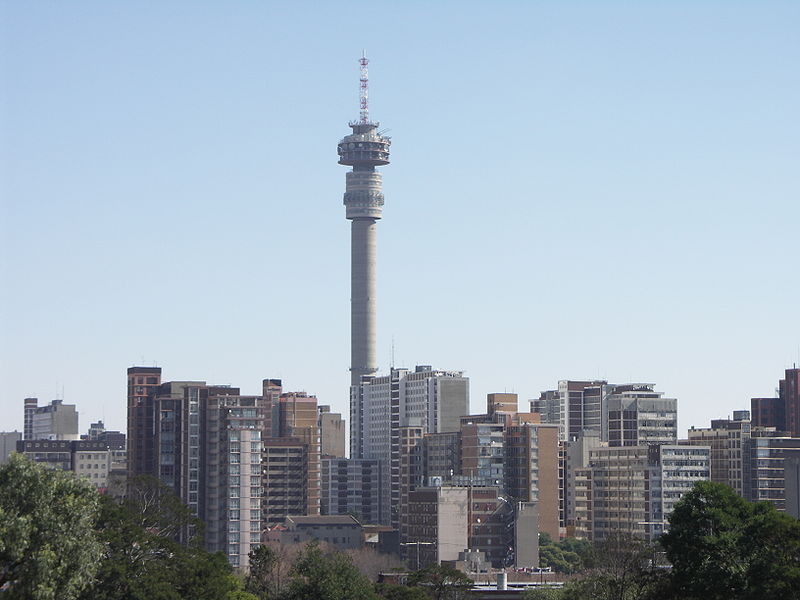
Hillbrow Tower in Johannesburg, South Africa. Courtesy of Wikipedia.
The provincial capital of Gauteng, the wealthiest province in South Africa, Johannesburg is located at about 26 °S, 28 °E. Johannesburg’s economy is centered around the lucrative gold and diamond trade. The city is also hosting the 2010 FIFA World Cup final, which is coming up this Sunday between the Netherlands and either Germany or Spain. Johannesburg is home to 3.9 million people (6.3 million in the metro).
A few more facts about Johannesburg (from Wikipedia):
- Time zone: South Africa Standard Time (UTC+2)
- Elevation: 5,751 ft above mean sea level
- Climate zone: Subtropical highland
- Average high temperature: 71 °F (22 °C)
- Average low temperature: 50 °F (10 °C)
- Average annual precipitation: 28 inches (713 mm)
Current weather: It is currently winter in Johannesburg, so the days are sunny and mild and in the 60s with lows near freezing. South Africa is at a latitude that is frequently dominated by high pressure, and this time is no exception, with a surface high in place and a ridge aloft, thus keeping the weather fairly pleasant (though nights could be cold). Sunday’s Weather Underground forecast for the World Cup calls for clear skies with a high of 62 °F and a low of 35 °F, while the South African Weather Service forecast calls for a high of 18 °C (64 °F) and a low of 1 °C (34 °C).
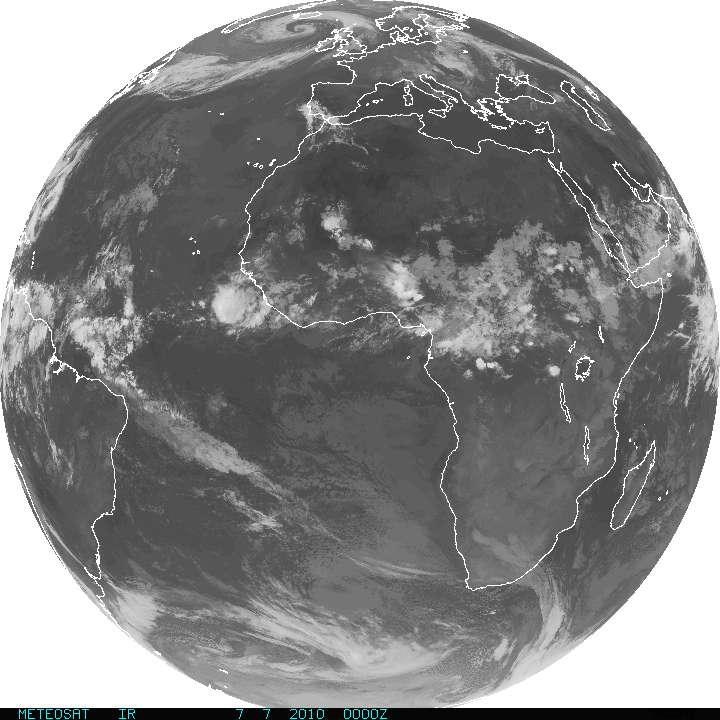
00Z (2 AM in Johannesburg, 5 PM in Los Angeles) METEOSAT infrared satellite image of Africa, showing clear skies over southern Africa. Courtesy of the GOES website. Click to enlarge.
For more information on Johannesburg, here’s a link to Wikipedia.
For weather maps and information on current and forecast Johannesburg weather, see the South African Weather Service site.
Next Tuesday I plan to take a look at the climate and weather in another part of the globe. As always, if you have any comments or suggestions for future cities, please leave a comment on this post!
Permalink
06.22.10
Posted in Non-US Weather, Weather News at 8:18 pm by Rebekah
This week’s post in the global weather and climate series features Amundsen-Scott South Pole Station, Antarctica.
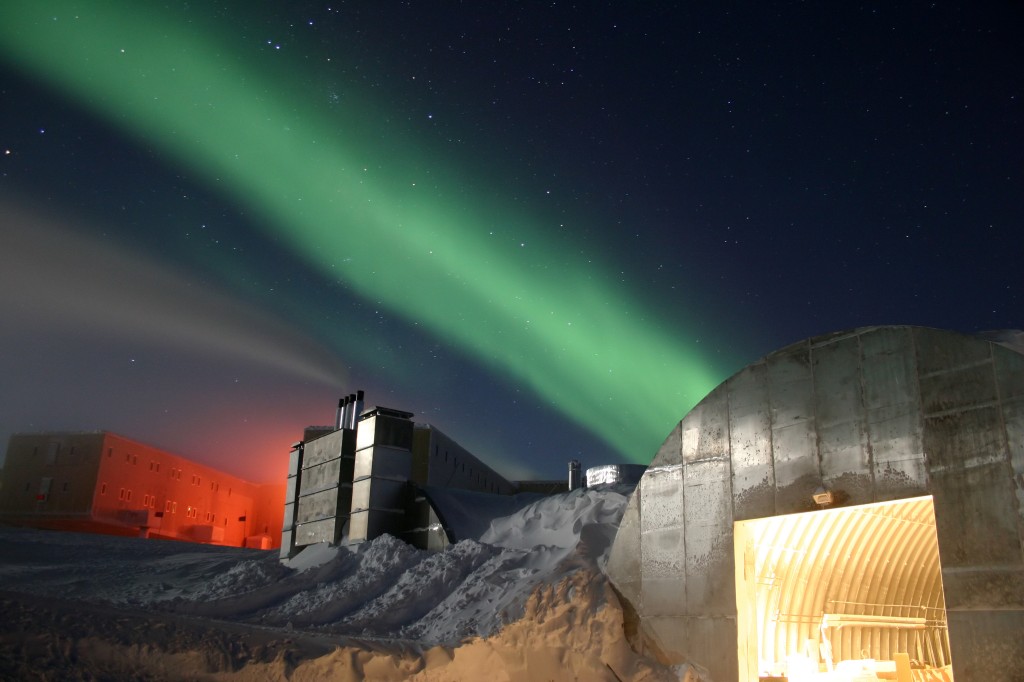
Amundsen-Scott South Pole Station, Antarctica, during the winter (the Aurora Australis is seen in the sky). Courtesy of Wikipedia.
Located at the geographic South Pole (90 °S, 0 °E), the Amundsen-Scott South Pole Station is a US research station that is home to over 200 people in the summer and several dozen in the winter. The sun only rises once a year, on the September equinox (first day of spring for the southern hemisphere), and only sets once a year, on the March equinox (first day of fall for the southern hemisphere). Antarctica is the coldest, highest, windiest, driest, and iciest continent on earth.
A few more facts about Amundsen-Scott (from Wikipedia):
- Time zone: New Zealand Standard Time (UTC+12) or New Zealand Daylight Time (UTC+13)
- Elevation: 9,301 feet above mean sea level
- Climate zone: Polar desert
- Average high temperature: -18 °F (-28 °C)
- Average low temperature: -76 °F (-60 °C)
- Record high temperature: 8 °F (-14 °C)
- Record low temperature: -117 °F (-83 °C)
- Average annual precipitation (liquid water equivalent of the snow): 3 inches (76 mm)
Current and forecast weather: Currently it is winter at the South Pole, and the temperature right now is -97 °F, with snow falling. Keep in the mind the sun has not risen in 3 months and will not do so for another 3 months, so there is no insolation for the research station at present.
You can see the current and forecast weather at the South Pole on the Weather Underground page here.
For more information on Amundsen-Scott, here’s a link to Wikipedia.
Next Tuesday we’ll be back to looking at the weather and climate in another part of the globe. As always, if you have any comments or suggestions for future cities, please leave a comment on this post!
Permalink
« Previous Page — « Previous entries « Previous Page · Next Page » Next entries » — Next Page »







